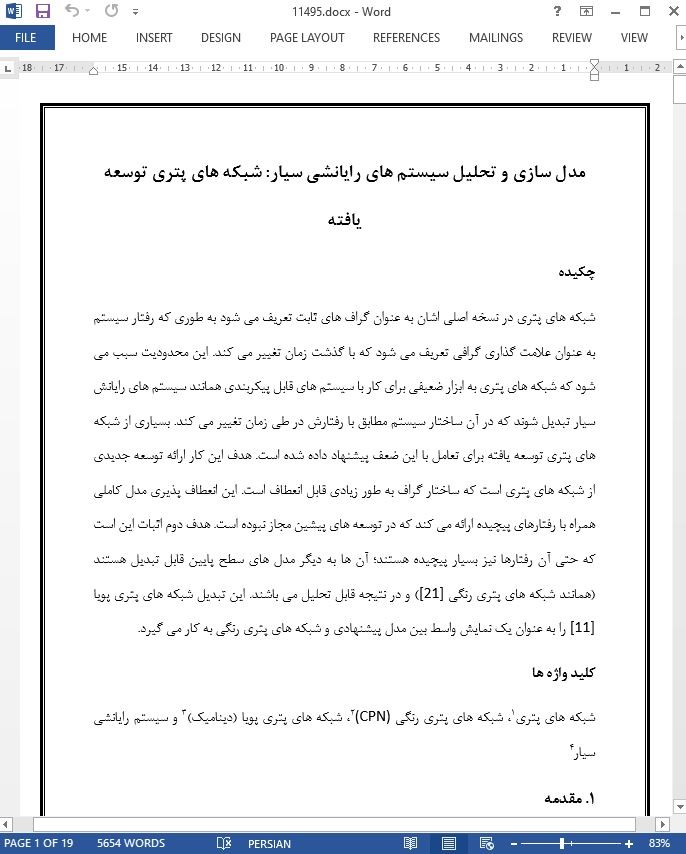
مدل سازی و تحلیل سیستم های رایانشی سیار: شبکه های پتری توسعه یافته
چکیده
شبکه های پتری در نسخه اصلی اشان به عنوان گراف های ثابت تعریف می شود به طوری که رفتار سیستم به عنوان علامت گذاری گرافی تعریف می شود که با گذشت زمان تغییر می کند. این محدودیت سبب می شود که شبکه های پتری به ابزار ضعیفی برای کار با سیستم های قابل پیکربندی همانند سیستم های رایانش سیار تبدیل شوند که در آن ساختار سیستم مطابق با رفتارش در طی زمان تغییر می کند. بسیاری از شبکه های پتری توسعه یافته برای تعامل با این ضعف پیشنهاد داده شده است. هدف این کار ارائه توسعه جدیدی از شبکه های پتری است که ساختار گراف به طور زیادی قابل انعطاف است. این انعطاف پذیری مدل کاملی همراه با رفتارهای پیچیده ارائه می کند که در توسعه های پیشین مجاز نبوده است. هدف دوم اثبات این است که حتی آن رفتارها نیز بسیار پیچیده هستند؛ آن ها به دیگر مدل های سطح پایین قابل تبدیل هستند (همانند شبکه های پتری رنگی [21]) و در نتیجه قابل تحلیل می باشند. این تبدیل شبکه های پتری پویا [11] را به عنوان یک نمایش واسط بین مدل پیشنهادی و شبکه های پتری رنگی به کار می گیرد.
1. مقدمه
توسعه فناوری های علوم رایانه ای و افزایش نیازمندی های کاربر از جمله محرک های اصلی تولید راهکارهای پیچیده هستند. تحرک به همراه جنبه های نرم (تحرک کد) و سخت (تحرک دستگاه) یکی از این راهکارها است. هنگامی که برخی از رویدادها یک سیستم حیاتی را در طی اجرا به مخاطره می اندازند، به نظر می رسد که انتقال این سیستم و ذخیره حالت آن به حالت و محل امن دیگر که می تواند اجرای خود را ادامه دهد، می تواند ایده خوبی باشد. منظور ما از تحرک نرم سیستمی است که کد می تواند از یک محل به محل دیگر مهاجرت کند. دلایل بسیاری می تواند سبب چنین مهاجرتی شود و روش ها و تکنیک های متعددی قابل استفاده است.
5. نتیجه گیری
سیستم های سیار سیستمی هایی با یک ساختار پویا هستند. ساختار آن ها با اجرا تغییر می کند. این دسته از سیستم ها در بسیاری از حوزه های زندگی روزانه ما وجود دارند. ربات های سیار برای بررسی محیط های خصمانه مورد استفاده قرار می گیرند، عامل های سیار در اینترنت یا در سیستم های توزیع شده به کار گرفته یم شوند، نودهای سیار در شبکه های بی سیم سیار مورد استفاده قرار می گیرند و غیره. تمامی این سیستم ها به عنوان سیستم های قابل پیکربندی مجدد در نظر گرفته می شوند.
Abstract
In its basic version, Petri Nets are defined as fixed graphs, where the behaviour of the system is modelled as the marking of the graph which changes over time. This constraint makes the Petri Nets a poor tool to deal with reconfigurable systems as mobile computing systems, where the structure of the system can change as its behaviour, during time. Many extended Petri nets were proposed to deal with this weakness. The aim of this work is to present a new extension of Petri Nets, where the structure of the graph can be highly flexible. This flexibility gives a rich model with complex behaviours, not allowed in previous extensions. The second aim is to prove that even these behaviours are so complex; they can be translated into other low level models (as Coloured Petri Nets [21]) and so be analysed. This translation exploits Dynamic Petri Nets [11] as an intermediary representation between our model and Coloured Petri Nets.
1 Introduction
The development of computer science technologies and increasing user requirements are the major drivers of the birth of sophisticated solutions. Mobility with its soft (code mobility) and hard (device mobility) aspects is one of these solutions. When some disaster menaces a critical system during its execution, it seems a good idea to transfer this system and to save its state to another, more secure site, where it can continue its execution. By soft mobility, we mean a system where code can migrate from one site to another site. Many reasons can cause such migration and many methods and techniques can be used.
5 Conclusion
Mobile Systems are systems with a dynamic structure. Their structure changes as they are executed. This class of systems can be found in many domains of our life. Mobile robots used to explore hostile environment, mobile agents used in the internet or in distributed systems, mobile nodes in a mobile wireless networks ... All these systems can be considered as reconfigurable systems.
چکیده
1. مقدمه
2. شبکه های توسعه یافته قابل پیکربندی مجدد برچسب گذاری شده (ELRN)
2-1 تعریف رسمی
2-2 مفاهیم
2-3 یک نمونه مدل سازی
3. تجزیه و تحلیل شبکه ELRN
4. کارهای مرتبط
5. نتیجه گیری
Abstract
1 Introduction
2 Extended labelled reconfigurable nets
2.1 Formal definition
2.2 Semantics
2.3 A modelling example
3 On the analysis of ELRN
4 Related works
5 Conclusion
- اصل مقاله انگلیسی با فرمت ورد (word) با قابلیت ویرایش
- ترجمه فارسی مقاله با فرمت ورد (word) با قابلیت ویرایش، بدون آرم سایت ای ترجمه
- ترجمه فارسی مقاله با فرمت pdf، بدون آرم سایت ای ترجمه



